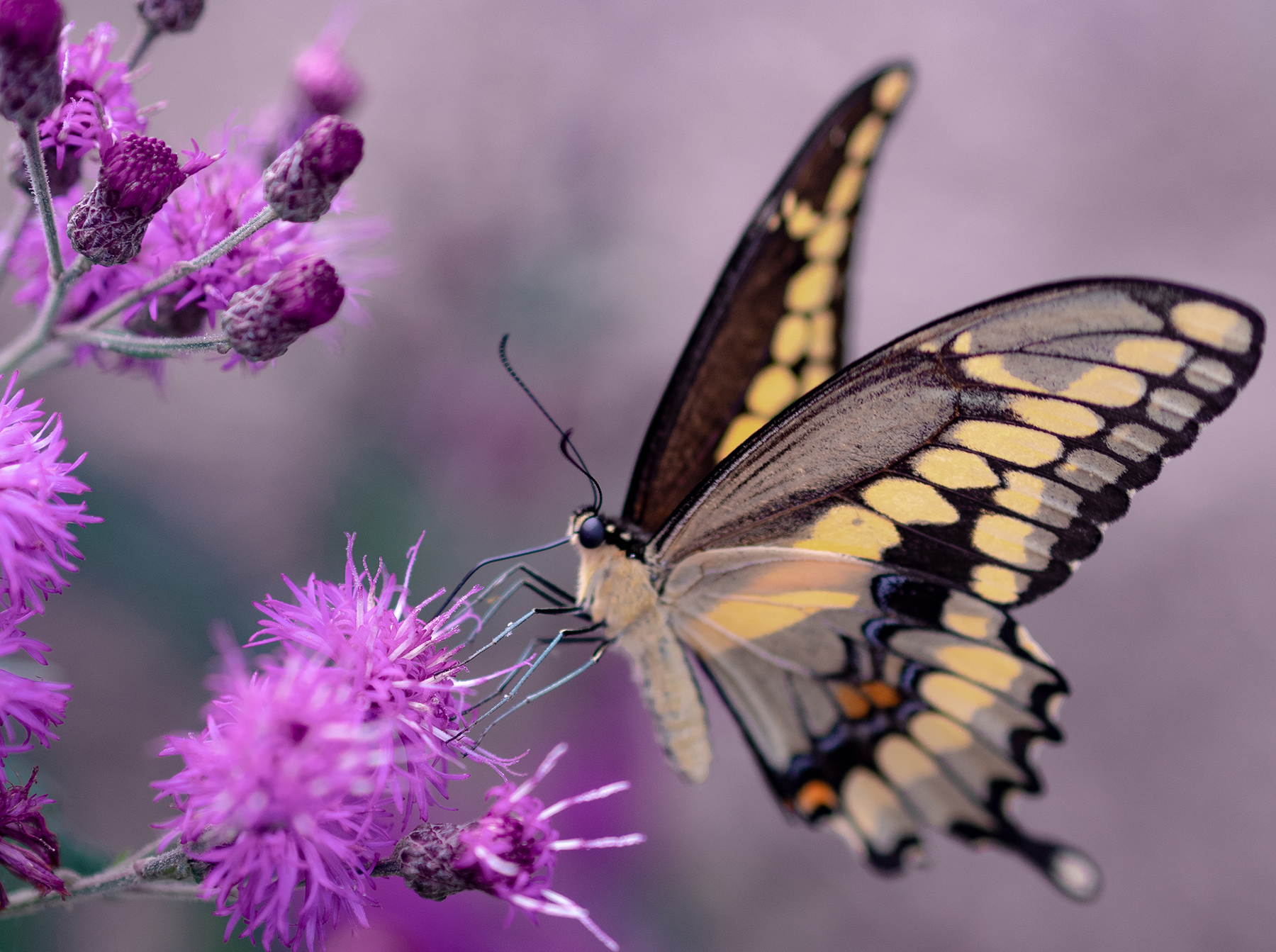When I was a little girl, my mom bought a butterfly farm—one of those big boxes with a see-through side so my brother and I could watch the caterpillars grow and change. I remember sitting eagerly by the box every day, giggling at the caterpillars as they waddled around their home and grew positively chubby.
I remember waiting impatiently through the long, silent days after they spun their cocoons. I remember my excitement when the butterflies finally burst free.
But I also recall my grief when the smallest butterfly—who I’d named “Wrinkly-Wings”—died before my very eyes. The affectionate moniker I’d given her unfortunately foretold her fate: she’d survived the dramatic process of metamorphosis, but for some reason her wings were too crumpled and frail to fly. Within an hour or two she was dead. I cried bitterly, and my mom gave her a proper funeral in our flower bed.
Over twenty years later my family and I no longer live in the city, and we have no reason to buy butterfly farms: butterflies flock to our kitchen garden, clover, and salvia. This spring, however, we’ve once again witnessed one of the most spectacular transformations in all of nature—and we can thank our two new milkweed plants for that.
Honestly, I didn’t pay much attention to the milkweeds when they first arrived in their big brown pots. On one hand, I’m still recovering from shattering my elbow back in February, so my gardening efforts have pretty much been reduced to seed-planting and slow, clumsy weeding. On the other, milkweed isn’t the fairest plant of all. Its lanky, gangly stems don’t exactly scream “elegance.” (And yes, I admit it’s a shallow reason, but even a gardener can be guilty of prejudice.)
So for the first week or so, I was far more preoccupied with trying to remember to water my tomato seedlings than I was with the milkweed. What I didn’t realize is that milkweed is the only viable nursery on the planet for one of the world’s tiniest, bravest creatures: the monarch butterfly.
Imagine my surprise, then, when my mom announced one day with pride and delight, “The milkweed is crawling with caterpillars.” Over the next few days we counted well over a dozen. I soon made a habit of checking on them every morning, laughing to myself as they made short work of the milkweed’s emerald leaves.
And then the same process I witnessed as a child began to unfold. Pale green cocoons, speckled with gold, appeared overnight around the rims of the milkweed pots. But as the days passed, the memory of poor little Wrinkly-Wings rose up to haunt me. The sight of one dead caterpillar hanging blackened and limp next to all those well-spun cocoons didn’t help: something had gone wrong before it could even weave its own chrysalis. All this risk, all this work, and they still might not survive their journey!
As you might’ve guessed at this point, it’s never been easy for me to “trust the process.” The idea of falling back on elementary principles and tested truths makes me panic a bit. My automatic response has always been to press forward and not lean back. After all, if I fall back I might fall flat. I might end up helpless, vulnerable, or looking like a fool, and that’s terrifying.
I’ve had to reckon with this admittedly unhealthy mindset these past few months. My accident in February did knock me flat. I’ve wept in fear, discouragement, and pain more times than I can count…and yet the people who know me best have told me I’ve shown great courage during this experience. It’s startling. I don’t feel courageous. In fact, my panic over my inability to control or speed up the healing process has left me feeling very small and frightened.
But my good old friend, the dictionary, doesn’t describe courage as the absence of fear. Rather, it is “the ability to do something that frightens one.” It is “strength in the face of pain or grief.” When I adopt that perspective, I can take a deep breath and say, “Okay…maybe I do have a little courage.”
Yet the dictionary fails to clarify one important point: courage never happens in a vacuum. You don’t just wake up one morning and decide that today you shall be courageous. Like any other virtue, it must be planted and nurtured in a safe place before it can come into full flower.
This is where the caterpillars and the milkweed come back in. I’m enough of a realist to know an insect doesn’t have the emotional intelligence to feel fear, but it doesn’t take much effort to imagine a trembling caterpillar as she weaves her own cocoon, desperately hoping she survives the violent changes that’ll take place inside. Maybe she takes heart in the fact that she isn’t walking into this unprepared or unequipped. For days and days the milkweed’s leaves have been her feast as well as her armor, their toxicity leaching into her body and protecting her from predators who might otherwise have found her a tasty treat. She’s built up the energy and strength she needs to form her chrysalis and undergo her transformation. No other plant could’ve provided her with what she needs on this journey. And if she wasn’t certain of all of these things, she might not have the courage to be self-digested in darkness and emerge as something completely new.
Five caterpillars reappeared—albeit unrecognizable—on a Thursday afternoon. I’d gone to physical therapy that morning, and on the way to the doctor’s office I’d shared some of my fears about my “new normal” with my mother. After I poured my heart out to her (and tried very hard not to cry), she smiled.
“I just know that God loves you so much,” she said. “He knows what’s best for you, and He’s going to bring good things out of this very hard thing. And who knows? Maybe He’s preparing you for something you can’t even imagine right now.”
Well, I did cry then. But her words were still on my mind that afternoon as I got on my knees and my one good hand in front of the milkweed, snapping photos of monarch butterflies as they sunned themselves and tried out their new wings. My dad commented that butterflies are a picture of resurrection, and he’s absolutely right—but they’re also a picture of courage that isn’t self-sufficient or self-generating.
It’s a courage that grows because it relies on something greater than itself.
It has been nourished from a self-giving source…and it takes risks because it trusts in the good and perfect preparation.
As I continue on my own journey, I take comfort in knowing I don’t have to drum up my courage all by myself, either. Like the caterpillars on the milkweed, I’ve been protected, nurtured, and fed by my Heavenly Father…and even when life seems dark and scary, He will not let me go. Armed with that sure and certain hope, even I can look forward to my own transformation.
The featured image is courtesy of Aaron Burden.
You can see more of Aaron’s remarkable images here and here.
Maribeth Barber Albritton is an author, wife, mother, and small business owner. She serves as Director of Media and Communications for The Cultivating Project and contributes to the production of Cultivating Magazine’s print editions. She also works as an Executive Assistant at The C.S. Lewis Foundation.
Maribeth has a deep love for history, literature, and film. These keen interests inspired her debut science-fiction novel, Operation Lionhearted, as well as her blog, A Writer’s Tale, where she’s written a number of book and movie reviews from the angle of the Christian imagination.
Maribeth, her pastor-husband Casey, and their daughter Molly live in rural Mississippi in a red-brick manse they’ve affectionately named “Crickhollow.”
Leave a Reply
A Field Guide to Cultivating ~ Essentials to Cultivating a Whole Life, Rooted in Christ, and Flourishing in Fellowship
Enjoy our gift to you as our Welcome to Cultivating! Discover the purpose of The Cultivating Project, and how you might find a "What, you too?" experience here with this fellowship of makers!


I enjoyed your story so much, Maribeth! Beautifully written! Blessings on you with your stories to come!
Love you! Mrs. Corky
I’m so glad you enjoyed it, Mrs. Corky! Love you bunches!
Maribeth, I loved reading about how family life and the beauty and wisdom embedded in the Creation are speaking to you during this healing season. That was encouraging to me. Thank you.
Matthew, my apologies for such a late reply! I’m so blessed to know that my article encouraged you. Thank you for commenting!
Lovely to catch up again Maribeth – so glad your injury healed sufficiently for you to begin your novel. I am 75 years in November so cannot read all the input at once but I always enjoy anything ‘Christ centred’ – what a delight in today’s world. keep going……we look forward to reading more…….
Thank you so much for checking in, Christina! In many ways I’m still in the middle of the healing process, but I’m so grateful that I’m finally at the point where I can be creative again. I’m so delighted that you enjoyed my article–it means a lot to me!